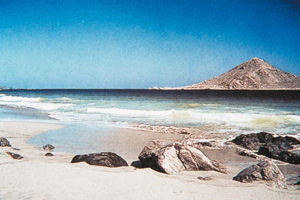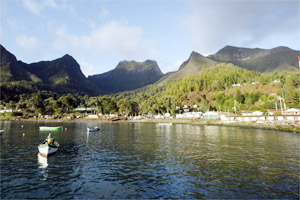This zone takes up what is nowadays known as the region of Arica and Parinacota down to the region of Coquimbo. Archeological investigation shows that human life flourished in this portion of the country 11,000 years ago. The main cultures that inhabited the Greater North and Lesser North are:
– Chinchorro culture (6000-2000 b.C.): they developed in the Archaic period, occupying the zone that goes from the port of Ilo in Peru down to Antofagasta in Chile.
They were fishermen, hunters and gatherers, mainly of marine products. They were organized in small groups of approximately 30 to 50 people, who were apparently related to each other.
Their main characteristic was their particular vision regarding death, highlighting the rites they performed on their dead, like mummification. This procedure consisted on the extraction of the deceased’s muscles and organs, which were switched with vegetables, feathers, wool, leather, among other materials.
Then, the body was covered with a layer of clay and after this, with human hair. A kind of wig was fabricated, which was placed on the head.
This culture’s art was almost exclusively based on making the mummies’ delicate funerary furnishings, which included turbans made of ropes manufactured from plant or animal fibers and highly elaborate textiles. Sometimes they placed knives and other instruments.
Towards the year 2000 b.C., the chinchorros interlaced with the Quiani groups, who would later become the heirs of this culture.
– Cabuza culture (500-1000 a.C.): during the Agri-pottery period and under the influence of the Tiwanaku culture (central Andes), this culture settled among the valleys of Chile’s far north (Camarones) and the south of Peru (Ilo).
They lived in small villages and indigenous settlements located near rivers, living in rectangular homes with stone foundations and walls made of cane and totora plant tied with ropes.
Their economy was mainly based on agriculture, employing more complex instruments and sophisticated irrigation systems for its development, which allowed the cultivation of corn, beans, and squash, among others.
They also devoted themselves to metallurgy, working on gold and silver, being able to make pendants and rings with representations of flames. Other types of handicrafts included spoons and flasks or keros made of wood and fine textiles.
Their deceased were buried in round pits with the bodies placed in a fetal position or squatting, wrapped in wollen shirts, tied with totora plant ropes and accompanied by mortuary offerings.
– Arica culture (1000-1532 a.C.): made up of a group of feudal manors or kurakazgos directly descendent from the Cabuza. They also developed in the Agri-pottery period.
They inhabited Mollendo (Peru) down to Taltal (Chile) and their economy was sustained by agriculture and marine gathering.
The ceramics, which was their main handicraft, presented several styles, all characterized by their great technique, among which were: San Miguel, which had red or black designs on white and the Pocoma-Gentillar that had red, black and white over a natural background.
They also worked on copper to make pins, hooks and other instruments, as well as gold as silver to make adornments.
They had a shamanic religious system, which was reflected in the importance given to the instruments used to inhale hallucinogenic substances and liquids.
– Faldas del Morro (foothills of the Morro) culture (900 b.C.-400 a.C.): this civilization developed in the Agri-pottery period and they were located at the far north of the country. They are believed to be the first to live in villages. They were small and located on terraces, protected from the wind and near springs.
Their economy combined horticulture with the gathering and hunting of marine and terrestrial species.
Their artistic expressions were related to mortuary offerings and rites. In addition, they spun llama wool, which they used to make textiles, combining colors like blue, red and brown.
– San Pedro or Atacameña culture (500 b.C.-1536 a.C.): also originating in the Agri-pottery period, this northern culture settled between the Loa river and the basin of the Atacama saltpan.
Their social organization was based on a group of families that spawned lineages or Ayllus, which had a chief or lord, who could be told apart from the rest for dressing in fine weaves, metal adornments and headdresses made from bird feathers.
Their economy was based on agriculture (they cultivated corn, chili, squash and beans) and camelid cattle (llamas and alpacas), complemented with the gathering of fruit from the Geoffroea decorticans (chañar) and Prosopis chilensis (algarrobo).
Their villages, which were of great size, were found near saltpans and oases. They had their farmlands and cemeteries in the surrounding areas. Their ceramics were preferably characterized by red or black objects with a globular (spherical) shape, with necks and a flat base. They also made objects in carved wood related to the consumption of hallucinogens. Another activity was the fabrication of objects made of metal, like copper, tin, silver, bronze and gold.
Just like other Chilean aborigines, they believed there was life after death. This was demonstrated by the way they placed their relatives underground, leaving them next to their weapons and clothes, personal objects, adornments and food.
– Pica or «Pica-Tarapaca» culture (900-1532 a.C.): they also developed during the Agri-pottery period and their territory consisted of the inner valley of Camiña and the mouth of the Loa river.
They politically organized themselves as hierarchical manor, which was in the charge of an authority that ordered the workers within a delimited territory.
Their economy was based on agriculture developed at the oases and ravines, the main crops of which were corn and quinoa. In addition, they gathered fruit from the Prosopis chilensis (algarrobo) and Prosopis tamarugo (tamarugo), hunted wild animals and exploited the coast’s resources.
Their characteristic art was cave paintings, meaning paintings and engravings made of the rocky surface of caves. They represented different aspects of domestic life using geometric figures, animals and anthropomorphisms.
In textiles, they made thick blankets and polychrome weaves. They also worked on leather and made baskets.
Their dead were buried in individual graves, although there were some where there was more than one person.
– Diaguita culture (900-1536 a.C.): belonging to the Agri-pottery period, this culture inhabited the Greater North, from the Copiapo river (region of Atacama) to the Choapa river (region of Coquimbo).
Their main activities were agriculture and cattle farming. The first was characterized for the abundance of crops like corn, beans, squash, potato and quinoa, all of them eased by the use of irrigation channels, and the second included the breeding of camelids.
The civilization was organized in small villages made up of huts made with branches, straw and mud to which they added underground cellars used for storing corn and other foods.
The Diaguita community was run by local leaders, but after the arrival of the Incas (1470 a.C.), society was reorganized in dual systems, meaning, it was split into two halves (one in the central valley and another on the coast), each one independent from the other with their own chief.
It is said the inhabitants had tanned skin and long hair and were muscular. They had the custom of painting their faces with black lines and triangles. Their extinction took place in less than 50 years with the arrival of the Spanish to Chilean territory.
Their ceramics are a real artistic treasure to this day due to its varied shapes and diverse colors. In addition, they were metallurgical craftsmen, making, for example, adornments in bronze, copper and silver.
– El Molle culture (200 b.C.-700 a.C.): they developed at the end of the early stages of the Agri-pottery period from Copiapo (region of Atacama) to the Choapa river (region of Coquimbo). They were sedentary and lived in villages.
They developed agriculture and among their crops were corn, beans, squash and quinoa. They also hunted camelids and stood out for being the first ceramicists of the Lesser North. A few of their ceramic products (flasks and jugs) were characterized for being very well polished and sometimes carved with animal or pumpkin shapes.
Cultures of central Chile
The civilizations that lived between the regions of Valparaiso and O’Higgins were characterized for living in the early and late stages of the Agri-pottery period.
– Llolleo Culture (300-800 a.C.): this civilization from the early part of the Agri-pottery period developed between the Choapa (region of Coquimbo) and Cachapoal (region of O’Higgins) rivers.
Their villages were characterized for having a great population density and because their inhabitants survived by hunting, gathering sea products and cultivating quinoa and corn. They also grinded grains.
They buried their dead with funerary furnishings beneath the floor of their dwellings, in some cases forming small home cemeteries.
In the case of children, they were buried in urns made of white clay.
Their pottery was recognized for their fine globular jugs, which many times represented human figures and faces. They also made small, two-handled pots engraved with geometric designs and jugs that resembled the shape of a pumpkin.
– El Bato (300-800 b.C.): they settled in the central zone of Chile, in the area between the mouth of the Petorca river (region of Valparaiso) and the Cachapoal river (region of O’Higgins).
This culture’s families –who lived in the early stages of the Agri-pottery period- buried their dead in a bent position under the floor of their dwellings along with funerary furnishings made up of tembetas, an adornment inserted between the lower lip and chin. In the case of the coastal settlements, the deceased were buried amongst seashell pilings with no offerings.
Their ceramics were characterized for recreating animal and plant shapes, probably of camelids and pumpkins.
– Aconcagua culture (900-1536 a.C.): they belonged to the Agri-pottery period and were concentrated in the zones of the Aconcagua (region of O’Higgins), Mapocho and Maipo (Metropolitan region) river basins. Their population was very numerous and they lived in small villages with simple homes made of mud, straw and Chusquea culeou (coligüe).
Their economy was based on the cultivation of quinoa and corn and breeding guanacos. Other activities were the hunting of animals in the valley and gathering shellfish along the coast. In addition, they extracted copper from the mountains by hand.
Their cemeteries were characterized for the great concentrations of graves built as funerary tumuli or ancuviñas, with a height that went from 30 centimeters to a couple of meters. The deceased were buried under them individually or collectively, accompanied by funerary furnishings made up of ceramic pots, copper earrings, necklaces, etc.
Potters made different type of ceramics, standouts among them were orange bottles, pots and bowls, which were sometimes decorated with geometric designs.
Southern cultures
They lived in vast Andean forests and on the coast that goes from the current region of Biobio to the region of los Lagos. They were characterized for having easily adapted to these habitats, which provided abundant wild terrestrial (plants and animals) and marine (like fish and algae) resources.
– Pitren culture (600-1532 a.c.): in the Agri-pottery period, the Pitren were the first horticulturist civilization (they cultivated corn and beans) that lived between the Biobio river (region of Biobio) and the north bank of lake Llanquihue (region of los Lagos). However, this activity was not their main sustenance; it was the gathering of wild fruit like pine nuts and hunting guanacos and deer.
The details of their everyday life are ignored to this day, all that is known is that their dwellings were located on small clearings within the forests, although they constantly switched places. The archeological sites known today are mostly cemeteries, in which a variety of artifacts have been found, such as pipes and pieces of pottery. The latter category was characterized by the manufacturing of jugs in the shapes of animals, people and pumpkins. They are recognized as the zone’s oldest. They also made globular shaped bottles, which they painted red or black.
– El Vergel culture (1000-1500 a.C.): in the latter part of the Agri-pottery period, this civilization was concentrated in the Itata (region of Biobio) and Tolten (region of la Araucania) rivers. They did not form villages, only family groups that settled on the coast, valleys and mountains for long periods. They developed a small-scale agriculture, as well as gathering wild fruit and raising camelid cattle.
They buried their deceased in great urns or ceramic earthenware jugs, sometimes colored in red and white.
Different degrees of development
After several archeology conferences, in 1961 specialists managed to reach a consensus and a chronological chart was made in order to establish the periods which the history of the first civilizations that inhabited our territory are divided into.
For the more ancient times, the name Paleo-Indian is used (until approximately 9000 b.C.). In this period there were hunters and gatherers who had also perfected techniques for manufacturing tools.
Then follows the Archaic period (9000-1500 b.C.), which is subdivided into three stages: early, middle and late. This is according to the technology the hunters had and also to the characteristics of their social and economic activities.
Finally, there is the phase known as the Agri-pottery period (1500 b.C. to 1470 a.C.), where agriculture appears, the first villages are formed and commercial activities take place among the small villages. This period is also subdivided into early, middle and late epochs.
In 1536, with the arrival of the Spanish, the pre-Hispanic period came to an end and the phase known as the Hispanic period began.
Paleo-Indian traces
At least four sites have been discovered on Chilean territory that attest to the Paleo-Indian period. They have been found throughout a long zone that goes from the region of Coquimbo to the region of Magallanes. The following can be counted among them: Quereo (region of Coquimbo), Tagua-Tagua (region of Libertador Bernardo O’Higgins), Monte Verde (region of los Lagos) and Cueva Fell (region of Magallanes).
One of the most investigated ones (ever since the seventies) is the Monte Verde site. It is said that its inhabitants lived in a woody environment, and they would have made their houses by making use of said lumber resources, which they roofed with animal skins. There are also signs that they hunted mastodons (a species of prehistoric elephant that had two great tusks) with spears armed with rudimentary stone tips. In addition, they gathered plants for food and medicine.
– Cultures of the northern zone
– Cultures of central Chile
– Southern cultures








